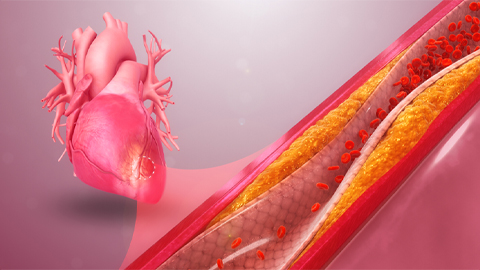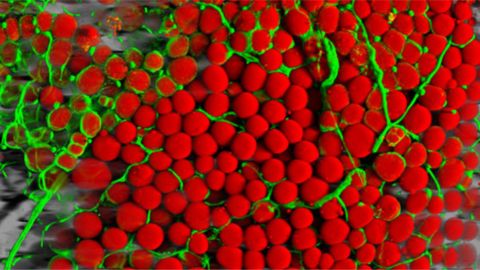E-cigarettes drive irreversible lung damage via free radicals
Thousands of substances in tobacco cigarettes can cause cancer. In the early 2000s, Chinese pharmacist Hon Lik invented electronic cigarettes, or e-cigarettes, which many believed were a safer alternative to tobacco cigarettes. E-cigarettes deliver nicotine, the substance in tobacco cigarettes, making them addictive, without many of the cancer-causing, or carcinogenic, substances found in traditional cigarettes. However, scientists have found that e-cigarettes may not be as safe as many once thought. For instance, e-cigarettes bring harmful side effects such as an increased risk of cardiovascular disease.

In a recent study published in the Journal of Biological Chemistry, an international group of researchers led by Jay L. Zweier of the Ohio State University found that nicotine exposure through the use of e-cigarettes, colloquially known as vaping, led to lung injury in mice. The researchers showed that aldehyde oxidase, or AOX, a critical enzyme in the process of nicotine metabolism, mediates this effect. In this study, Zweier and colleagues established a link between e-cigarette vapor exposure, nicotine metabolism and lung injury and explored the molecular basis for this connection.
“Inherently, they’re all still nicotine delivery devices,” Zweier said, referring to e-cigarettes. “So, we wanted to know if there is toxicity from nicotine itself.”
Zweier’s team previously that AOX generates superoxide, a reactive oxygen molecule that causes cell stress and damage. Furthermore, another group reported that nicotine iminium, or NICI, an intermediate product of nicotine metabolism, is a potent AOX substrate. In the current study, Zweier and his colleagues directly showed that NICI metabolism by AOX triggers high-level production of superoxide. They further sought to understand the connection between extended nicotine exposure, superoxide generation by AOX and lung injury.
To achieve this, the researchers designed a study in which they placed mice into chambers where they received whole-body nicotine exposure from e-cigarette vapor, at similar concentrations a person would receive while vaping, six hours per day for up to 16 weeks. The team then assessed the mice’s organ damage using biochemical methods.
“Using a mouse model allowed us to predict the effects of chronic exposure in humans,” Zweier said. “When we normalize the lifespans, about a year of exposure in mice corresponds to about three decades in humans.”
Zweier and colleagues showed that exposure to nicotine from e-cigarette vapor increased the expression of the Aox1 gene in mice by more than six times the normal amount. Zweier and his colleagues found e-cigarette vapor also drove increased superoxide levels as well as molecular markers that indicate oxidative damage in the lung, such as carbonylated proteins, oxidized guanine species and nitrated tyrosine. They reversed these effects when they treated mice with raloxifene, an AOX inhibitor.
“E-cigarette juice can have a nicotine concentration as high as 150 millimolar,” Zweier said. “And we saw that (lung) toxicity occurs at micromolar levels (1000 times less). It’s just off the scale.”
In the future, Zweier hopes to investigate the doses and duration of exposure to nicotine that will cause lung injury. This is important, he said, because the U.S. Federal Drug Administration is currently attempting to regulate e-cigarettes, and these devices are the most popular tobacco products among youth.
“We need to know what level of nicotine is tolerable, and what level is toxic,” Zweier said. “Not only to the lung, but also to the whole body.”
Enjoy reading ASBMB Today?
Become a member to receive the print edition four times a year and the digital edition monthly.
Learn moreGet the latest from ASBMB Today
Enter your email address, and we’ll send you a weekly email with recent articles, interviews and more.
Latest in Science
Science highlights or most popular articles

Parsing plant pigment pathways
Erich Grotewold of Michigan State University, an ASBMB Breakthroughs speaker, discusses his work on the genetic regulation of flavonoid biosynthesis.

Calcium channel linked to cancer drug resistance
Researchers discover a protein associated with carboplatin-resistant retinoblastoma, suggesting this protein could be a promising therapeutic target. Read more about this recent Journal of Biological Chemistry paper.

Host fatty acids enhance dengue virus infectivity
Researchers in Germany find that viral replication depends on host enzymes that synthesize lipids, revealing potential metabolic targets for antiviral intervention. Read more about this recent Journal of Biological Chemistry paper.

Antibodies inhibit hyperactive protein disposal
Researchers at the University of California, San Francisco, identify an enzyme inhibitor, offering new tools to study diseases like cystic fibrosis, neurodegeneration and cancer. Read more about this recent Journal of Biological Chemistry paper.

Scientists find unexpected correlation between age and HDL-C levels
In a 30-year multicenter study, researchers determined what factors predict HDL-C concentration. In their analysis, they found that HDL-C levels grew with increasing age and physical activity.

Butter, olive oil, coconut oil — what to choose?
Depending on the chain length and origin of the fat, regular fat consumption changes the specific makeup of fats in bloodstream and affect mild to severe cholesterol patterns. Read about this recent Journal of Lipid Research study.

